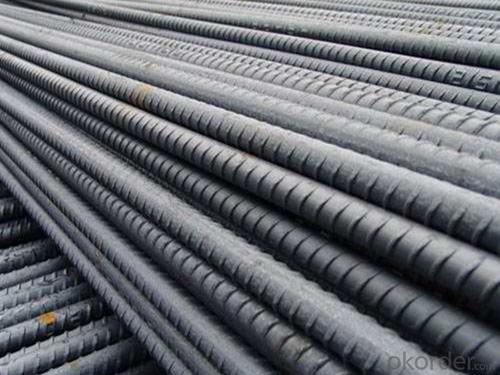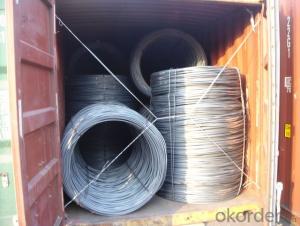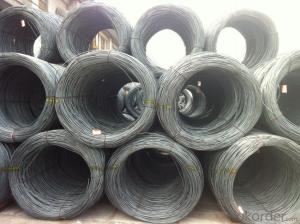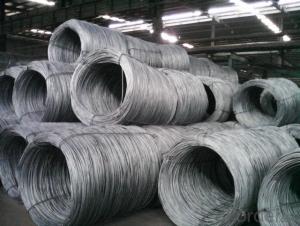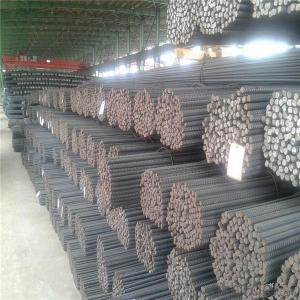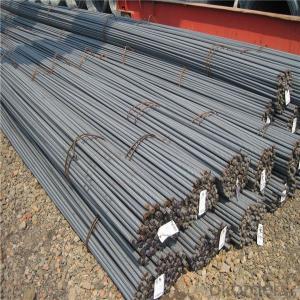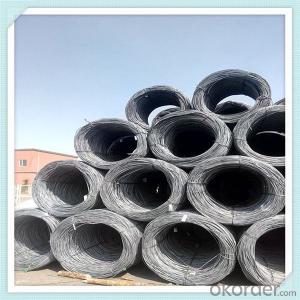Prime Hot Rolled Reinforcement Steel Rebar / Iron Rods
- Loading Port:
- Tianjin
- Payment Terms:
- TT OR LC
- Min Order Qty:
- 500 m.t.
- Supply Capability:
- 1000000 m.t./month
OKorder Service Pledge
OKorder Financial Service
You Might Also Like
1. Introduction:
.commodity:steel wire rod
.grade:Q195,SAE1008B-SAE1018B
.diameter:5.5mm-14mm
.type:in coil
.coil weight:around 2 mt
2. Specifications:
| Products | hot rolled steel rebar |
| 1.Standards | GB/BS/ASTM/DIN/JIS |
| 2.Grade | HRB335,HRB400,HRB500,G460B,B500A-C/BST500S/SD390/400 |
| 3.Diamter | 6,8,10,12,14,16,18,20,22,25,28,32,36mm |
| 4.MOQ | 20 tons each size |
| 5.Application | framework of reinforced concrete building component civil engineering construction,like house,bridge,road,etc |
| 6.Payment | T/T, L/C |
| 7.Delivery | 20-40 days |
| 8.Advantages | full size, competitive price and quality |
3.Application:
Applicationwidely used in machinery parts, manufacturing industry, electronics industry, metal tools and others
4. Pictures

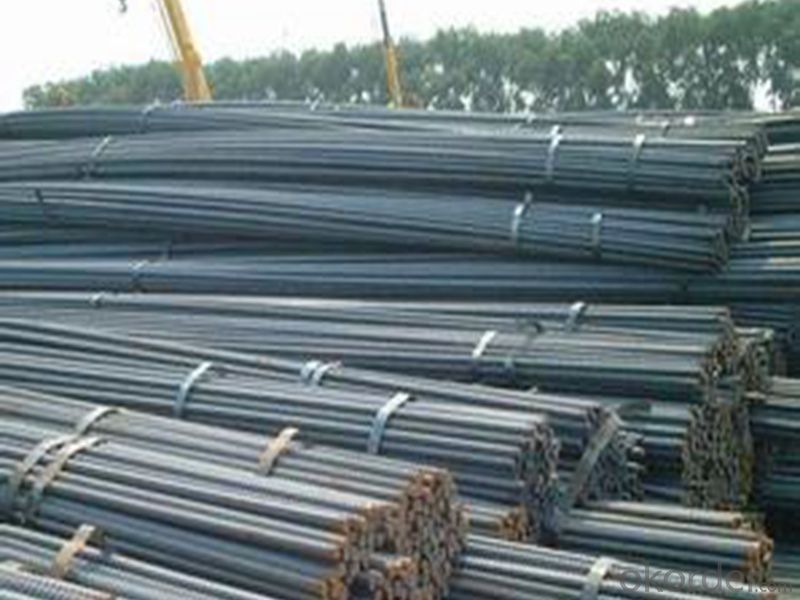
5.FAQ
We have organized several common questions for our clients,may help you sincerely:
①How about your company?
A world class manufacturer & supplier of castings forging in carbon steel and alloy steel,is one of the large-scale professional investment casting production bases in China,consisting of both casting foundry forging and machining factory. Annually more than 8000 tons Precision casting and forging parts are exported to markets in Europe,America and Japan. OEM casting and forging service available according to customer’s requirement.
②How to guarantee the quality of the products?
We have established the international advanced quality management system,every link from raw material to final product we have strict quality test;
- Q: What are the common applications of high-strength steel wire rod?
- High-strength steel wire rods are commonly used in a variety of applications, including construction, automotive, aerospace, and manufacturing industries. They are often used for reinforcement in concrete structures, such as bridges and buildings, due to their superior strength and durability. In the automotive industry, high-strength steel wire rods are utilized for the production of suspension systems, seat frames, and safety components. They are also essential in the aerospace sector for manufacturing aircraft components and engines. Additionally, high-strength steel wire rods find applications in manufacturing processes, such as wire mesh, springs, and cables, due to their ability to withstand high stress and resist deformation.
- Q: What are the different types of steel wire rod finishes for improved wear resistance in high-temperature environments?
- There are several types of steel wire rod finishes that can enhance wear resistance in high-temperature environments. Some common finishes include galvanized, stainless steel, and heat-treated. Galvanized finishes involve coating the wire rod with a layer of zinc, providing corrosion resistance and improved durability. Stainless steel finishes are highly resistant to corrosion and oxidation, making them suitable for high-temperature applications. Heat-treated finishes involve subjecting the wire rod to heat and then rapidly cooling it, resulting in increased hardness and wear resistance.
- Q: What are the common production processes for titanium-coated steel wire rod?
- The common production processes for titanium-coated steel wire rod include wire drawing, cleaning and pickling, titanium coating, and heat treatment.
- Q: What are the common industry best practices for steel wire rod distributors?
- Some common industry best practices for steel wire rod distributors include maintaining a robust supply chain management system, ensuring quality control and product traceability, providing timely and accurate order fulfillment, offering competitive pricing, establishing strong relationships with suppliers and customers, investing in modern technology and equipment for efficient operations, and prioritizing customer satisfaction through excellent communication and after-sales support.
- Q: How are steel wire rods used in the manufacturing of tire reinforcements for durability?
- Steel wire rods are used in the manufacturing of tire reinforcements for durability by being embedded within the rubber to provide strength and support. The rods help to reinforce the tire's structure, making it more resistant to punctures, impacts, and wear. This reinforcement enhances the tire's overall durability, allowing it to withstand the rigors of daily use and provide a longer service life.
- Q: What are the different packaging materials used for steel wire rod?
- There are several different packaging materials commonly used for steel wire rods. These materials are chosen based on factors such as the length and weight of the wire rods, the level of protection required during transportation, and the ease of handling for both the manufacturer and the end user. Here are some of the most commonly used packaging materials for steel wire rods: 1. Steel Coils: One of the most popular packaging options for steel wire rods is to bundle them into coils. The wire rods are wound tightly into a coil shape using a winding machine. This method provides a compact and secure packaging solution, making it easy to transport and handle the wire rods. 2. Wooden Reels: For longer and heavier wire rods, wooden reels are often used. The wire rods are wound around a wooden reel, providing a larger and more stable packaging option. Wooden reels are commonly used for wire rods that are used in construction and industrial applications. 3. Pallets: Another packaging option for steel wire rods is to stack them on wooden or plastic pallets. This method provides a stable base for the wire rods and allows for easy handling using forklifts or pallet jacks. Pallets are commonly used for bulk shipments of wire rods. 4. Cardboard Boxes: Smaller wire rods or wire rods with specific length requirements may be packaged in cardboard boxes. These boxes provide protection against damage during transportation and allow for easy handling and storage. 5. Plastic Wraps: In some cases, steel wire rods may be packaged using plastic wraps. This method is often used for smaller quantities or when the wire rods need to be protected from moisture or dust during transportation. It is important to note that the choice of packaging material may vary depending on the specific requirements of the wire rod manufacturer and the end user. Factors such as cost, transportation method, and storage conditions can also influence the selection of packaging materials.
- Q: How is steel wire rod used in the production of wire mesh reinforcement?
- Steel wire rod is used in the production of wire mesh reinforcement by being drawn through a series of dies to reduce its diameter and increase its length. This process, known as cold drawing, results in a strong and flexible wire that is then woven or welded together to create wire mesh reinforcement. The steel wire rod serves as the foundation for the wire mesh, providing strength and stability to the structure it supports.
- Q: How is steel wire rod used in the manufacturing of suspension cables?
- Steel wire rod is commonly used in the manufacturing of suspension cables due to its high strength and durability. Suspension cables are essential components in various structures like bridges, suspension bridges, cable-stayed bridges, and suspension cable systems in buildings. These cables are responsible for carrying the load of the structure and ensuring its stability. Steel wire rod is the primary material used to make suspension cables because of its unique properties. The high tensile strength of steel wire rod allows it to withstand heavy loads and forces without breaking. This strength is crucial in suspension cables as they need to support the weight of the entire structure and resist the forces of wind, earthquakes, and other external factors. In the manufacturing process, steel wire rod is first drawn through a series of dies to reduce its diameter and increase its length. This process, called wire drawing, refines the steel wire rod and improves its mechanical properties. The resulting wire is then coated with a protective layer, such as zinc or epoxy, to prevent corrosion and increase its lifespan. After the wire has been processed, it is twisted together with other wires to form strands. These strands are further twisted together to create a cable. The number of strands and the arrangement of wires within the strands depend on the specific requirements of the suspension cable. Once the suspension cable is manufactured, it is installed and tensioned in the structure. The high strength of the steel wire rod ensures that the cable can withstand the applied tension and support the weight of the structure effectively. The durability of the steel wire rod also ensures that the suspension cable remains reliable and safe for an extended period. In summary, steel wire rod plays a vital role in the manufacturing of suspension cables due to its high strength, durability, and corrosion resistance. It is the primary material used to create these cables, ensuring their ability to support heavy loads and maintain the stability of various structures.
- Q: How does the price of steel wire rod fluctuate?
- The price of steel wire rod fluctuates due to various factors such as supply and demand dynamics, changes in raw material costs, production capacity utilization, and global economic conditions. Additionally, market conditions, trade policies, and industry competition also play a role in influencing the price of steel wire rod.
- Q: What are the different types of steel wire rod surface finishing processes?
- There are several types of steel wire rod surface finishing processes, including pickling, galvanizing, phosphating, electroplating, and powder coating.
Send your message to us
Prime Hot Rolled Reinforcement Steel Rebar / Iron Rods
- Loading Port:
- Tianjin
- Payment Terms:
- TT OR LC
- Min Order Qty:
- 500 m.t.
- Supply Capability:
- 1000000 m.t./month
OKorder Service Pledge
OKorder Financial Service
Similar products
Hot products
Hot Searches
Related keywords



